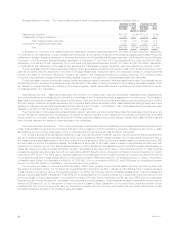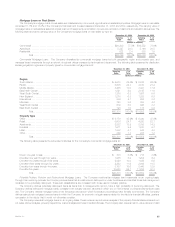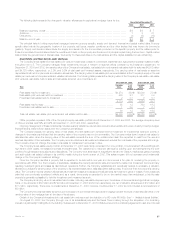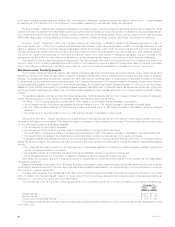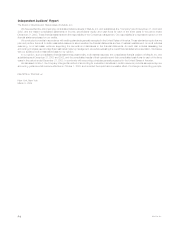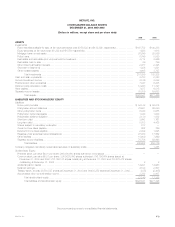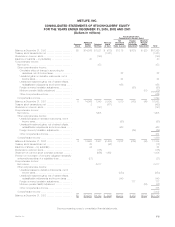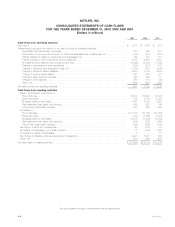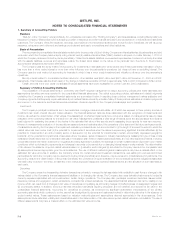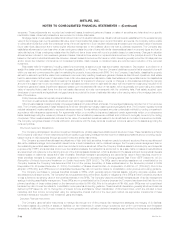MetLife 2003 Annual Report Download - page 45
Download and view the complete annual report
Please find page 45 of the 2003 MetLife annual report below. You can navigate through the pages in the report by either clicking on the pages listed below, or by using the keyword search tool below to find specific information within the annual report.
bond calls, mortgage prepayments and defaults. New York Insurance Department regulations require that MetLife perform some of these analyses
annually as part of the annual proof of the sufficiency of its regulatory reserves to meet adverse interest rate scenarios.
Hedging activities. MetLife’s risk management strategies incorporate the use of various interest rate derivatives that are used to adjust the overall
duration and cash flow profile of its invested asset portfolios to better match the duration and cash flow profile of its liabilities to reduce interest rate risk.
Such instruments include financial futures, financial forwards, interest rate and credit default swaps, floors, options, written covered calls and caps.
MetLife also uses foreign currency swaps and foreign currency forwards to hedge its foreign currency denominated fixed income investments.
Economic Capital. Beginning in 2003, the Company changed its methodology of allocating capital to its business segments from RBC to
Economic Capital. Prior to 2003, the Company’s business segments’ allocated equity was primarily based on RBC, an internally developed formula
based on applying a multiple to the NAIC Statutory Risk-Based Capital and includes certain GAAP accounting adjustments. Economic Capital is an
internally developed risk capital model, the purpose of which is to measure the risk in the business and to provide a basis upon which capital is deployed.
The Economic Capital model accounts for the unique and specific nature of the risks inherent in MetLife’s businesses. This is in contrast to the
standardized regulatory RBC formula, which is not as refined in its risk calculations with respect to the nuances of the Company’s businesses.
This change in methodology is being applied prospectively. This change has and will continue to impact the level of net investment income and net
income of each of the Company’s business segments. A portion of net investment income is credited to the segments based on the level of allocated
equity. This change in methodology of allocating equity does not impact the Company’s consolidated net investment income or net income.
Risk Measurement; Sensitivity Analysis
The Company measures market risk related to its holdings of invested assets and other financial instruments, including certain market risk sensitive
insurance contracts (‘‘other financial instruments’’), based on changes in interest rates, equity prices and currency exchange rates, utilizing a sensitivity
analysis. This analysis estimates the potential changes in fair value, cash flows and earnings based on a hypothetical 10% change (increase or decrease)
in interest rates, equity prices and currency exchange rates. The Company believes that a 10% change (increase or decrease) in these market rates and
prices is reasonably possible in the near-term. In performing this analysis, the Company used market rates at December 31, 2003 to re-price its invested
assets and other financial instruments. The sensitivity analysis separately calculated each of MetLife’s market risk exposures (interest rate, equity price
and foreign currency exchange rate) related to its non-trading invested assets and other financial instruments. The Company does not maintain a trading
portfolio.
The sensitivity analysis performed included the market risk sensitive holdings described above. The Company modeled the impact of changes in
market rates and prices on the fair values of its invested assets, earnings and cash flows as follows:
Fair values. The Company bases its potential change in fair values on an immediate change (increase or decrease) in:
)the net present values of its interest rate sensitive exposures resulting from a 10% change (increase or decrease) in interest rates;
)the U.S. dollar equivalent balances of the Company’s currency exposures due to a 10% change (increase or decrease) in currency exchange
rates; and
)the market value of its equity positions due to a 10% change (increase or decrease) in equity prices.
Earnings and cash flows. MetLife calculates the potential change in earnings and cash flows on the change in its earnings and cash flows over a
one-year period based on an immediate 10% change (increase or decrease) in market rates and equity prices. The following factors were incorporated
into the earnings and cash flows sensitivity analyses:
)the reinvestment of fixed maturity securities;
)the reinvestment of payments and prepayments of principal related to mortgage-backed securities;
)the re-estimation of prepayment rates on mortgage-backed securities for each 10% change (increase or decrease) in the interest rates; and
)the expected turnover (sales) of fixed maturities and equity securities, including the reinvestment of the resulting proceeds.
The sensitivity analysis is an estimate and should not be viewed as predictive of the Company’s future financial performance. The Company cannot
assure that its actual losses in any particular year will not exceed the amounts indicated in the table below. Limitations related to this sensitivity analysis
include:
)the market risk information is limited by the assumptions and parameters established in creating the related sensitivity analysis, including the
impact of prepayment rates on mortgages;
)the analysis excludes other significant real estate holdings and liabilities pursuant to insurance contracts; and
)the model assumes that the composition of assets and liabilities remains unchanged throughout the year.
Accordingly, the Company uses such models as tools and not substitutes for the experience and judgment of its corporate risk and asset/liability
management personnel.
Based on its analysis of the impact of a 10% change (increase or decrease) in market rates and prices, MetLife has determined that such a change
could have a material adverse effect on the fair value of its interest rate sensitive invested assets. The equity and foreign currency portfolios do not expose
the Company to material market risk.
The table below illustrates the potential loss in fair value of the Company’s interest rate sensitive financial instruments at December 31, 2003 and
2002. In addition, the potential loss with respect to the fair value of currency exchange rates and the Company’s equity price sensitive positions at
December 31, 2003 and 2002 is set forth in the table below.
The potential loss in fair value for each market risk exposure of the Company’s portfolio, all of which is non-trading, for the periods indicated was:
December 31,
2003 2002
(Dollars in millions)
Interest rate risk ***************************************************************************************** $3,617 $2,710
Equity price risk ***************************************************************************************** $ 155 $ 120
Foreign currency exchange rate risk ************************************************************************ $ 619 $ 529
The change in potential loss in fair value related to market risk exposure between December 31, 2003 and 2002 was primarily attributable to a shift
in the yield curve.
MetLife, Inc.
42




